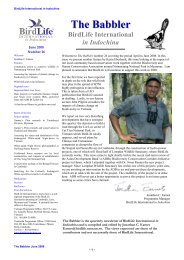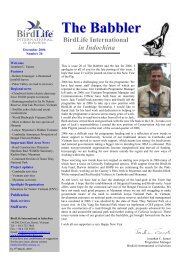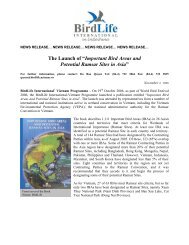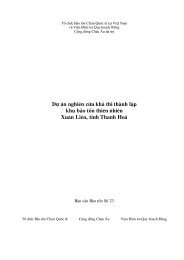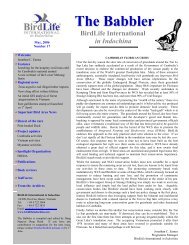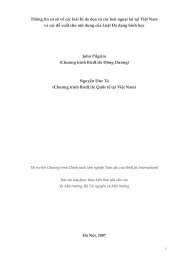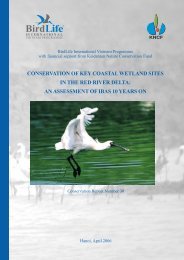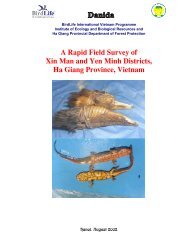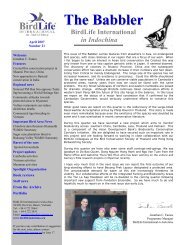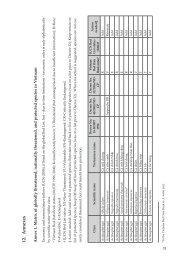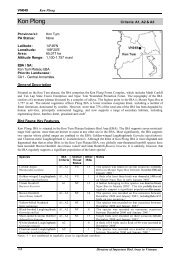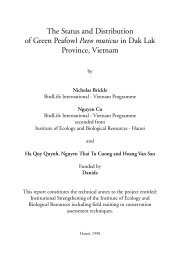The Biodiversity of Bac Huong Hoa Nature Reserve - Birdlife ...
The Biodiversity of Bac Huong Hoa Nature Reserve - Birdlife ...
The Biodiversity of Bac Huong Hoa Nature Reserve - Birdlife ...
You also want an ePaper? Increase the reach of your titles
YUMPU automatically turns print PDFs into web optimized ePapers that Google loves.
2.8.2 Medium quality forest<br />
Just over half <strong>of</strong> BHH NR is covered in medium quality forest. Lowland evergreen forest and<br />
mid-montane evergreen forest habitats in BHH NR have been strongly and negatively affected by<br />
people. Lowland evergreen forest has been extensively logged for high value timber and because<br />
it occupies the most productive agricultural land, it has also been cleared for shifting cultivation.<br />
Mid-montane evergreen forest has also experienced some selective logging and in common with<br />
lowland forest, it was affected by aerial spraying <strong>of</strong> chemical defoliants during the American<br />
War. Faunal and floral diversity <strong>of</strong> medium quality forest is considerably lower than that <strong>of</strong> high<br />
quality forest types.<br />
Secondary forest following shifting cultivation<br />
This is the dominant forest type on land below 600 m. In <strong>Bac</strong> <strong>Huong</strong> <strong>Hoa</strong>, short stature secondary<br />
forest develops 8-10 years after shifting cultivation. <strong>The</strong> plant composition, structure and<br />
appearance <strong>of</strong> this forest type, are completely different from primary forest. <strong>The</strong>re are very few<br />
lianas in secondary forest, fern diversity is low and orchids and arboreal ferns are typically<br />
absent. It is generally very dense and chaotic in structure, with no defined layers; however, the<br />
following four layers can sometimes be defined.<br />
Upper canopy layer: This layer is characterised by light-demanding tree species which have<br />
grown up from stumps or from the seed bank, following a cessation <strong>of</strong> farming activities. <strong>The</strong>se<br />
trees typically have a height <strong>of</strong> 8-10 m and a diameter <strong>of</strong> between 10 and 15 cm. Typically,<br />
species from the families Litsea, Machilus, Lindera, Lauraceae, Euphorbiaceae, Rutaceae,<br />
Ulmaceae, Fabaceae, Moraceae, Sapindaceae, Anacardiaceae and the genera Macaranga,<br />
Mallotus, Sapium, Bridelia, Canarium, and Ficus are found; as well as the species Endospermum<br />
sinensis, Euodia melifolia, Acronychia pedunculata, Gironniera subaequalis, Trema orientalis<br />
and Centis sinensis.<br />
Lower canopy layer: This layer is characterised by smaller trees, <strong>of</strong>ten similar to those in the<br />
upper canopy layer, and shrubs with a height <strong>of</strong> 5-7 metres. <strong>The</strong> families most <strong>of</strong>ten recorded in<br />
this layer are Rubiaceae, (especially Camellia spp. and Eugenia spp), <strong>The</strong>aceae (especially<br />
Grewia spp.) and Tilliaceae.<br />
Mid-story: This layer consists <strong>of</strong> small trees and shrubs. Typically, species from this layer<br />
include representatives from the families Melastomataceae, Rubiaceae, Verbenaceae and<br />
Arecaceae and in particular, Rapis excelsa.<br />
Understory: This layer is usually composed <strong>of</strong> ferns and grasses from the families Zingiberaceae<br />
and Araceae. In areas where light penetrates to the ground, members <strong>of</strong> the family Poaceae are<br />
<strong>of</strong>ten found and members <strong>of</strong> the Rubiaceae, Hydeotis and Acanthaceae families occur in humid<br />
places.<br />
2.8.3 Low quality forest and non-forest habitats<br />
Bamboo forest<br />
At elevations <strong>of</strong> 700-1200 m, degraded land is colonised by the large bamboo species<br />
Arundiunria peteloti. It reaches 3-5 metres in height and grows in dense stands. Interspersed with<br />
22




